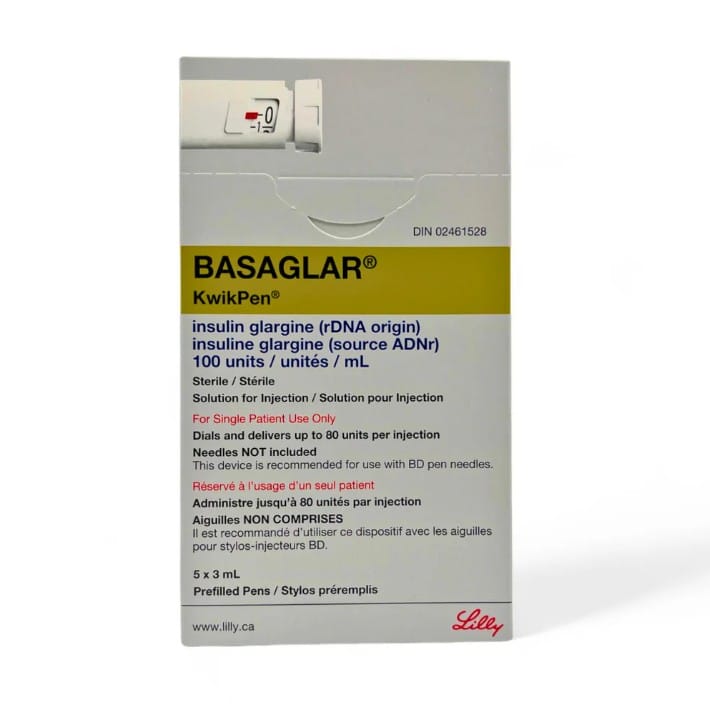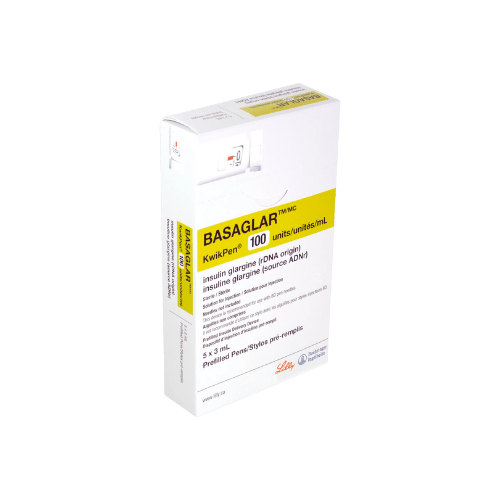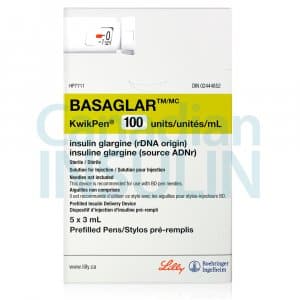Please note: a valid prescription is required for all prescription medication.
What Basaglar Is and How It Works
Basaglar® KwikPen is a long-acting insulin glargine used to help manage blood sugar in adults with type 2 diabetes and in adults and children with type 1 diabetes. This page explains how the pen works, how to use it safely, and how to access it with US shipping from Canada. You will also find practical details on access and costs without insurance.
CanadianInsulin.com is a prescription referral platform. We verify prescriptions with your prescriber when required, and licensed Canadian pharmacies dispense your order.
This insulin is designed to provide a steady, 24-hour basal effect. It releases slowly after injection, supporting fasting and between-meal control. It is not a mealtime insulin. For type 1 diabetes, it is typically used with a rapid-acting insulin for meals as directed by your clinician. The treatment is given by subcutaneous injection only; it is not for pumps or intravenous use.
People often compare options and the Basaglar insulin pens price when planning refills. The sections below cover dosing basics, handling, safety, and access.
Who It’s For
This medicine is indicated to improve glycemic control in adults with type 2 diabetes. It is also indicated in adults and pediatric patients with type 1 diabetes when a basal insulin is needed. It should not be used to treat diabetic ketoacidosis. If you have frequent hypoglycemia, significant liver or kidney disease, or a history of severe insulin allergy, discuss risks and alternatives with your healthcare professional.
Children using basal insulin require caregiver supervision. Seniors and those with renal or hepatic impairment may be at greater risk of low blood sugar and may need closer monitoring per the official label.
Dosage and Usage
Use once daily at the same time each day, or as instructed by your prescriber. For type 1 diabetes, a separate rapid-acting insulin is typically given with meals. For type 2 diabetes, this basal insulin may be used alone or with other diabetes medicines. Your clinician sets the starting dose and any changes. Do not adjust your dose on your own.
General administration tips:
- Check the label to confirm the correct product.
- Inspect the solution; use only if the liquid is clear and colorless.
- Attach a new sterile needle before each injection.
- Prime the pen as directed to ensure insulin flow.
- Inject into the abdomen, thigh, or upper arm fatty tissue.
- Rotate injection sites to reduce skin problems.
- Confirm the full dose was delivered by holding the needle in place for several seconds as instructed in the pen guide.
Never share pens or needles with anyone, even if the needle is changed. Sharing can transmit infections and is unsafe.
For more background on basal options, see our category for Long Acting Insulin Pens.
Strengths and Forms
The pen contains insulin glargine at 100 units/mL in a 3 mL prefilled disposable KwikPen. Common retail packs include cartons of five pens. Needle tips are typically sold separately. Availability can vary by pharmacy and region.
Missed Dose and Timing
If you miss a dose, take it when you remember on the same day, then resume your usual once-daily schedule. If it is nearly time for your next dose, skip the missed dose. Do not take two doses at once. Check your blood glucose more often after a missed dose and follow your clinician’s guidance.
Storage and Travel Basics
Unopened pens should be kept in a refrigerator and protected from light. Do not freeze. If a pen has been frozen, discard it. After first use, most pens can be kept at room temperature and should be used within the period in the official instructions. Keep away from heat and direct sunlight. Replace the cap after each use.
When traveling, carry pens in your hand luggage with a copy of your prescription. Use a protective case that cushions the pen and helps maintain safe temperatures. Keep backup needles and a glucose meter with you. For more details on best practices, read Insulin Storage Temperature.
Pen Handling and Sharps Disposal
Wash your hands before use. Attach a new pen needle, prime as directed, then dial the prescribed units. Insert the needle into the chosen site and deliver the dose. Keep the needle in place for the time stated in the Instructions for Use to ensure full delivery. Remove the needle after each injection and place it in an approved sharps container.
Do not reuse needles. Follow your local regulations for sharps disposal. Keep pens and supplies out of reach of children and pets.
Benefits
This basal insulin provides steady background coverage and can help reduce overnight and between-meal glucose elevations when used as directed. Once-daily dosing improves convenience for many adults. The pen format is portable, with dose dialing and a discreet design. For those requiring both basal and bolus insulin, consistent basal coverage may support a more stable daily plan alongside meal-time therapy.
Side Effects and Safety
- Low blood sugar symptoms: shakiness, sweating, fast heartbeat, hunger, headache
- Injection site reactions: redness, itching, or swelling
- Weight gain
- Peripheral edema
- Upper respiratory symptoms
Serious but less common risks can include severe allergic reactions and hypokalemia. Hypoglycemia is the most frequent adverse effect with any insulin and can be severe. Beta-blockers may mask some symptoms of low blood sugar. Do not drive or operate machinery if your glucose is low. Seek urgent care for severe reactions. Always review the full safety information in the official label.
Drug Interactions and Cautions
Medicines that can increase the risk of low blood sugar include other antidiabetic agents, salicylates, some antidepressants, and alcohol. Drugs that may raise blood glucose include corticosteroids, certain diuretics, and some antipsychotics. Thiazolidinediones can cause fluid retention; monitor for heart failure symptoms when used together. Potassium-lowering drugs may increase the risk of hypokalemia. Consult your clinician before starting or stopping any medicine.
Do not mix this insulin with other products or use it in an insulin pump. Use only as a subcutaneous injection. Confirm the product name before every dose to avoid mix-ups.
What to Expect Over Time
With regular use and glucose monitoring, many people see steadier fasting readings as basal coverage is established. Your prescriber may adjust the dose cautiously based on your glucose logs and goals. Maintain consistent timing each day. Track readings, meals, and activity to support informed clinical decisions. If affordability affects adherence, ask about options, including Insulin Products available through our platform.
Patients often compare Basaglar KwikPen Canadian pricing when planning multi-month refills or switching packs.
Compare With Alternatives
Several long-acting options may be appropriate alternatives when recommended by your prescriber. One is insulin glargine in another brand device, and another is insulin degludec. We offer both when a valid prescription is provided. You can review Lantus Solostar Pens and Tresiba Flextouch Pens to discuss with your clinician.
Pricing and Access
We list current options and the Basaglar KwikPen price transparently on each product page. You can also compare the Insulin glargine 100 units/mL KwikPen price across available pack sizes. Select a quantity that fits your care plan, and upload your prescription during checkout. We provide US delivery from Canada with clear tracking and responsive support. Checkout is encrypted to protect your information.
Looking for seasonal offers? See our current promotions on Promotions.
Availability and Substitutions
Stock and pack sizes can vary. If your preferred carton is unavailable, your prescriber may recommend a comparable alternative basal insulin or a different pack size. If needed, ask your clinician about switching plans or brands based on clinical suitability and access.
Many compare the Basaglar KwikPen 5×3 mL pens price with other pack formats before finalizing a refill.
Patient Suitability and Cost-Saving Tips
This therapy may fit adults with type 2 diabetes who need basal control, and adults or children with type 1 diabetes who require once-daily background insulin. Those with frequent hypoglycemia, severe renal or hepatic impairment, or a history of insulin allergy should review risks closely with a prescriber. Do not use if the solution is cloudy, colored, or contains particles.
Cost-saving ideas:
- Multi-month supply: fewer fills can reduce per-fill fees.
- Consistent timing: better adherence can avoid emergency purchases.
- Site rotation: helps avoid skin issues that disrupt dosing.
- Glucose logs: support efficient dose reviews at appointments.
- Benefit check: ask about coverage changes ahead of refills.
Some patients track the Basaglar KwikPen cash price and compare with insurer estimates before choosing a fill strategy.
For broader therapy context, see Common Diabetes Medications and our condition guide for Type 2 Diabetes.
Questions to Ask Your Clinician
- Starting plan: how should I time my basal dose each day?
- Monitoring: how often should I check fasting and overnight glucose?
- Meals and activity: how do exercise or skipped meals affect my basal needs?
- Sick-day rules: what should I do if I am ill or not eating?
- Safety: what are the key signs of hypoglycemia I must act on?
- Travel: how should I transport and store my pens during trips?
- Alternatives: which other basal insulins are suitable if access changes?
Authoritative Sources
Health Canada Drug Product Database
Ready to proceed? Complete your order with prompt, cold-chain shipping. Ships from Canada to US. This information is educational and does not replace guidance from your healthcare professional.
Express Shipping - from $25.00
Shipping with this method takes 3-5 days
Prices:
- Dry-Packed Products $25.00
- Cold-Packed Products $35.00
Standard Shipping - $15.00
Shipping with this method takes 5-10 days
Prices:
- Dry-Packed Products $15.00
- Not available for Cold-Packed products
How does this long-acting insulin work in the body?
It forms microprecipitates in the subcutaneous tissue after injection. These slowly release insulin over about a day, providing background coverage between meals and overnight. It is not designed for mealtime spikes. Use at the same time each day, and monitor glucose regularly. Your prescriber may pair it with rapid-acting insulin for meals in type 1 diabetes. Always follow the official label and your clinician’s instructions.
Can I use the pen with an insulin pump or mix it with other insulins?
No. This product is for subcutaneous injection by pen only. Do not use it in an insulin pump or administer intravenously. Do not dilute or mix it with other insulins. Mixing can change the action profile, which may affect safety and control. If you need both basal and bolus therapy, your clinician will prescribe a separate mealtime insulin and provide usage instructions.
What are common side effects I should know about?
The most common side effect with any insulin is hypoglycemia. Symptoms may include shakiness, sweating, headache, or fast heartbeat. Weight gain, injection site reactions, and mild swelling can also occur. Serious reactions, while less common, can include severe allergy and low potassium. If you suspect severe hypoglycemia or an allergic reaction, seek medical help right away. Review the full safety information in the official prescribing document.
How should I store unused and in-use pens?
Keep unused pens refrigerated and protected from light. Do not freeze. If a pen has been frozen, discard it. Once in use, most pens can be kept at room temperature and used within the timeframe in the Instructions for Use. Avoid heat and sunlight, and replace the cap after dosing. During travel, carry supplies in hand luggage and use a protective case to maintain appropriate temperatures.
What should I do if I miss a dose?
Take the missed basal dose when you remember on the same day, unless it is close to your next scheduled dose. If it is near the next dose, skip the missed dose and resume your routine. Do not double up. Check your glucose more often after a missed dose. Your clinician can advise on pattern management if missed doses are frequent.
Where can I inject, and how do I rotate sites?
Common sites include the abdomen, thigh, and upper arm. Rotate within and between areas to reduce skin thickening or irritation. Choose a new spot at least a finger-width from the last site. Avoid moles, scars, and areas that are tender or bruised. Proper rotation supports consistent absorption and reduces injection site problems over time.
What should I discuss with my clinician before starting?
Share your full medication list, including over-the-counter products and supplements. Discuss history of hypoglycemia, kidney or liver issues, heart failure, or insulin allergy. Ask how to recognize and treat low blood sugar, how often to check glucose, and how this basal fits with your meal plan and activity. Review travel storage needs and when to schedule follow-up to assess your glucose patterns.
Rewards Program
Earn points on birthdays, product orders, reviews, friend referrals, and more! Enjoy your medication at unparalleled discounts while reaping rewards for every step you take with us.
You can read more about rewards here.
POINT VALUE
How to earn points
- 1Create an account and start earning.
- 2Earn points every time you shop or perform certain actions.
- 3Redeem points for exclusive discounts.
You Might Also Like
Related Articles
National Diabetes Heart Connection Day—Why It Matters
Every year, millions of Americans are affected by both diabetes and heart disease, two conditions that are deeply linked but often managed separately. The American Heart Association reported that adults…
Does Ozempic Cause Insomnia? Facts You Shouldn’t Ignore
Ozempic (Semaglutide) has redefined how people approach diabetes and weight management. By helping control blood sugar levels while supporting healthy, steady weight loss, it offers a more holistic path to…
End the Scratching: How Atopica Capsules for Dogs Can Help
Constant scratching, licking, and biting are more than just annoying habits; they are signs of skin allergies or inflammation that can significantly affect a dog’s comfort and quality of life.…
Atopica Cats Medication: Relief for Itchy, Allergic Skin
When your cat constantly scratches, bites, or licks their skin, it’s not just uncomfortable for them; it can be heartbreaking to watch. Allergies in cats are more common than many…








